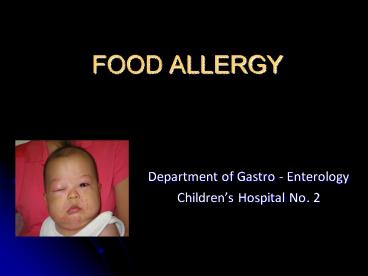FOOD ALLERGY - PowerPoint PPT Presentation
1 / 22
Title:
FOOD ALLERGY
Description:
A skin-prick test or tests for specific immunoglobulin E (IgE) antibodies (RAST) ... Linseeds, sesame seeds and poppy seeds. Mushrooms. Alcoholic drinks ... – PowerPoint PPT presentation
Number of Views:581
Avg rating:3.0/5.0
Title: FOOD ALLERGY
1
FOOD ALLERGY
- Department of Gastro - Enterology
- Childrens Hospital No. 2
2
References
- http//www.ebm-guidelines.com/
- Uptodate 2008
- Cochrane reviews
- Finnish Medical Society Duodecim. Paediatric food
hypersensitivity and allergy. In EBM Guidelines.
Evidence-Based Medicine Internet. Helsinki,
Finland Wiley Interscience. John Wiley Sons
2008 Apr 10 Various. 13 references
3
Introduction
- Food hypersensitivity food allergy food
intolerance. - Food allergy categorized
- IgE-mediated
- non IgE-mediated
- both mechanisms
- A skin-prick test or tests for specific
immunoglobulin E (IgE) antibodies (RAST) in the
serum may be used in the determination of an
immunological mechanism.
4
Introduction
- Most infants suffering from food allergy to
nutritionally important foods (milk, cereals)
recover at pre-school age. - School-aged children may develop allergy to
vegetables or fruit.
5
Epidemiology
- General population 2
- Young children (lt 3 yrs) 8
- Young children with severe eczema 90
- Children with asthma lt 10
6
Manifestations of food allergy
- 1. SKIN urticaria angioedema ? eczema
- 2. RESPIRATORY rhinitis asthma
- 3. GI TRACT diarrhea vomiting
- - eosinophilic
gastroenteritis - - enterocolitis
- 4. GENERAL anaphylactic shock
- 5. OTHER migraine, hyperactivity,
- sleep disturbances etc ?
7
Causes of Food Allergy
- Any food can cause allergy
- In children gt 90 of acute systemic reactions to
food (anaphylactic reactions) eggs, milk, soy,
wheat, or peanuts.
8
Foods triggering anaphylaxis in Singaporean
children (1992 1996)
- 124 children with acute anaphylaxis at NUH
- mean age (yrs)
- 1. Egg and milk 11 0.7
- 2. Birds nest 27 4.5
- 3. Chinese herbs 7 5.0
- 4. Crustacean seafood 24 11.0
- 5. Others 30 7.0
Chicken, duck, fruits (banana, rambutan),
cereals, gelatin and spices
Goh et al. Allergy 54, 1999, 78-92.
9
Cow's Milk and Cereal Allergies
- Nutritionally most significant (Räsänen Ylönen,
1992) - Mainly seen in young children
- Prevalence 2.5 during the first two years of
life (A review of 229 PubMed 1967 - 2001 ) - Rarely after pre-school age
- Symptoms caused by these foods usually appear in
infancy soon after the food has been introduced
to the child's diet.
10
Allergens Related to Pollen Allergy
- Allergens
- Root vegetables potato, carrot, celery
- Fruit and other vegetables apple, pear, peach,
kiwi fruit, plum, mango, tomato - Spices mustard, ginger, cinnamon
- Others walnut, almond
- In most cases preparation of vegetables (cutting,
freezing, and especially cooking) removes the
allergenicity, the majority of persons allergic
to pollen can eat cooked vegetables.
11
Other Allergens
- Peanuts, soya, fish, shellfish, eggs, wheat,
barley, oats, rye, buckwheat, banana, avocado - Linseeds, sesame seeds and poppy seeds
- Mushrooms
- Alcoholic drinks
- Cereal allergens, aniseed, colouring agents,
benzoic acid
12
Diagnosis of Food Allergy
- Skin-prick and radioallergosorbent tests (RAST)
for specific foods 85 sensitive, 30 - 60
specific. - ? specific IgE/blood
- Intradermal testing higher false-positive rate
higher risk for adverse reactions ? not be used
for the initial evaluation of food allergy. - Atopy patch tests diagnosis of non-IgE mediated
food allergy, not be recommended outside of
research settings - Most specific test to confirm the diagnosis is
still the double-blind, placebo-controlled food
challenge - GOLDEN STANDARD DBPCFC
13
Future immunomodulatory therapies for food allergy
- 1. Humanized monoclonal anti-IgE
- 2. Peptide immunotherapy
- 3. Immuno-stimulatory sequences
- 4. Probiotics (?) no effect on allergic
reactions
14
- Allergen immunotherapy for patients with food
allergy, chronic urticaria, and/or angioedema is
not recommended (National Guideline
Clearinghouse, level B)
15
Prevention
- To prevent allergies, the risk groups should be
identified reliably, and an efficient
preventative measure should be available (Csonka
et al., 2000). - Maternal antigen avoidance during lactation has
no effect on the incidence of atopic eczema in
the child according to one small study (Kramer
Kakuma, 2006) D.
16
Prevention
- Maternal avoidance of food allergens during
pregnancy (third trimester) does not prevent
atopic manifestations in the infant (Kramer
Kakuma, 2006) C. - All studies concerning prevention have been
carried out in children at high risk of atopy,
the evidence has been reviewed to be of poor
quality (Brand, Vlieg-Boerstra, Dubois, 2007).
17
Prevention
- Exclusive breast feeding for at least 4 to 6
months is recommended, but the allergy-preventing
effect of this is modest at best (Kramer
Kakuma, 2002).
18
Prevention
- Partially hydrolysed formulas are effective when
breast-feeding is not available for high-risk
infants (Baumgartner et al., 1998 Osborn Sinn,
2003) A.
19
Follow-Up
- Indications for referral to specialist care
- An infant with widespread eczema or worsening
symptoms - An infant with perplexing symptoms
- Failure to thrive
20
Follow-Up
- In primary care
- The growth charts of a child on an elimination
diet is monitored. - Vaccinations
- The family is encouraged to expand and
rationalize the diet towards a normal diet. - The child's diet should be re-evaluated at 5
years of age at the latest - All elimination diets at school-age should be
based on an established diagnosis.
21
Conclusion
- Primary prevention food allergen avoidance
important - Breast milk is best
22
Thank you for your attention !































